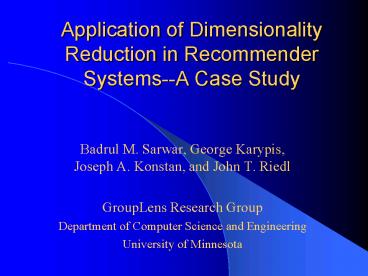Application of Dimensionality Reduction in Recommender Systems--A Case Study - PowerPoint PPT Presentation
Title:
Application of Dimensionality Reduction in Recommender Systems--A Case Study
Description:
Neighborhood formation. Prediction/Top-N recommendation ... Example. C1 rates recycled letter pads High. C2 rates recycled memo pads High. Both of them like ... – PowerPoint PPT presentation
Number of Views:34
Avg rating:3.0/5.0
Title: Application of Dimensionality Reduction in Recommender Systems--A Case Study
1
Application of Dimensionality Reduction in
Recommender Systems--A Case Study
- Badrul M. Sarwar, George Karypis,
Joseph A. Konstan, and John T. Riedl - GroupLens Research Group
- Department of Computer Science and Engineering
- University of Minnesota
2
Talk Outline
- Introduction to Recommender Systems (RS)
- Challenges
- Dimensionality Reduction as a Solution
- Experimental Setup and Results
- Conclusion
3
Recommender Systems
- Problem
- Information Overload
- Too Many Product Choices
- Solution
- Recommender Systems (RS)
- Collaborative Filtering
4
Collaborative Filtering
- Representation of input data
- Neighborhood formation
- Prediction/Top-N recommendation
5
Challenges of RS
- Scalability
- Enormous size of customer-product matrix
- Slow neighborhood search
- Slow prediction generation
- Sparsity
- May hide good neighbors
- Results in poor quality and reduced coverage
6
Challenges of RS
- Synonymy
- Similar products treated differently
- Increases sparsity, loss of transitivity
- Results in poor quality
- Example
- C1 rates recycled letter pads High
- C2 rates recycled memo pads High
- Both of them like
- Recycled office products
7
Idea Dimensionality Reduction
- Latent Semantic Indexing
- Used by the IR community for document similarity
- Works well with similar vector space model
- Uses Singular Value Decomposition (SVD)
- Main Idea
- Term-document matching in feature space
- Captures latent association
- Reduced space is less-noisy
8
SVD Mathematical Background
9
SVD for Collaborative Filtering
m x n
10
Experimental Setup
- Data Sets
- MovieLens data (www.movielens.umn.edu)
- 943 users, 1,682 items
- 100,000 ratings on 1-5 Likert scale
- Used for prediction and neighborhood experiments
- E-commerce data
- 6,502 users, 23,554 items
- 97,045 purchases
- Used for neighborhood experiment
- Train and test portions
- Percentage of training data, x
11
Experimental Setup
- Benchmark Systems
- CF-Predict
- CF-Recommend
- Metrics
- Prediction
- Mean Absolute Error (MAE)
- Top-N Recommendation
- Recall and Precision
- Combined score F1
12
Results Prediction Experiment
- Movie data
- Used SVD for prediction generation based on the
train data - Computed MAE
- Obtained similar numbers from CF-predict
13
Results Neighborhood Formation
- Movie Dataset (converted to binary)
- Used SVD for dimensionality reduction
- Formed neighborhood in the reduced space
- Used neighbors to produce recommendations
- Computed F1
- Obtained similar numbers from CF-Recommend
14
Results Neighborhood Formation
- E-Commerce Dataset
- Used SVD for dimensionality reduction
- Formed neighborhood in the reduced space
- Used neighbors to produce recommendations
- Computed F1
- Obtained similar numbers from CF-Recommend
15
Conclusion
- SVD results are promising
- Provides better Recommendations for Movie data
- Provides better Predictions for xlt0.5
- Not as good for the E-Commerce data
- Even up to 700 dimensions!
- SVD provides better online performance
- SVD is capable of meeting RS challenges
- Sparsity
- Scalability
- Synonymy
- A follow-up paper appears at EC00 conference































